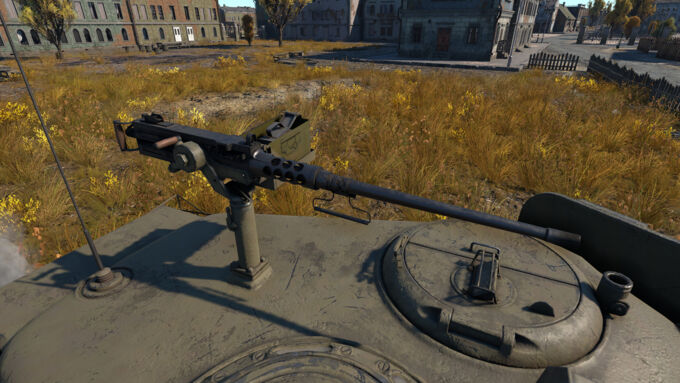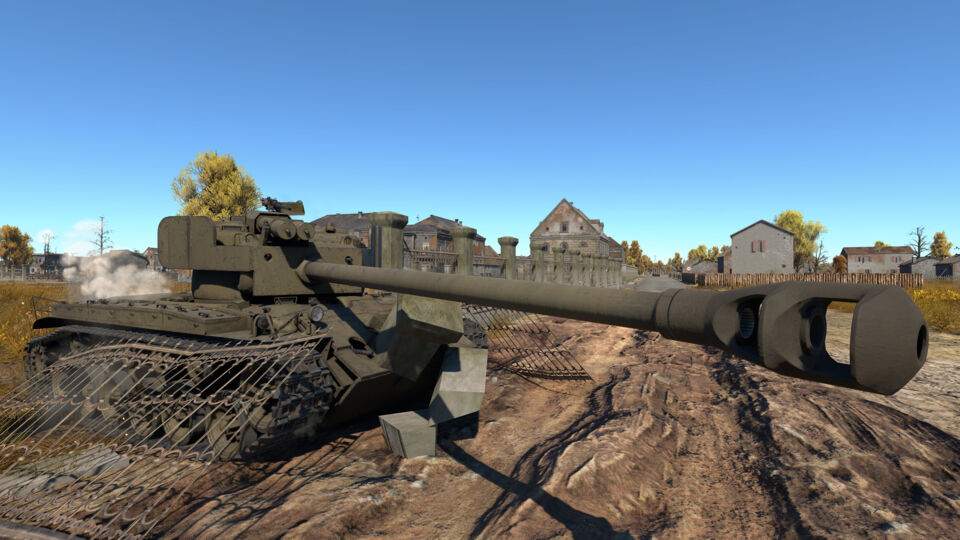The T26E1-1 “Super Pershing” is a famous up-gunned variant of the more ubiquitous M26 Pershing medium tank used by the United States Army during World War II. Deployed in the final months of the war, the Super Pershing was equipped with the powerful T15E1 cannon to rival the infamous German 8.8cm KwK 43 tank gun used by the Tiger II. In addition to its deadly main gun, the single Super Pershing sent to Europe received a unique appliqué armor package by soldiers of the 3rd Armored Division.
| Pros: | Cons: |
|---|---|
| Armament: The T15E1 cannon is a potent main gun that can reliably handle common threats. | Reload Speed: While powerful, the T15E1's long cartridges necessitate a lengthier reload. |
| Protection: The up-armored hull and turret provide a excellent amount of protection. | Weak Spots: Despite its overall armor thickness, the Super Pershing features several noticeable weak-spots in its armor. |
| Gun Handling: The Super Pershing features excellent gun handling typical of WW2-era American tanks. | Mobility: The Super Pershing’s heavy armor weighs it down, reducing mobility. |
Armaments
The T26E1-1 is equipped with the experimental T15E1 cannon, a roof-mounted M2HB heavy machine gun, and a coaxial M1919A4 machine gun.
90mm T15E1 Cannon
The T15E1 cannon, also known as the “long 90”, is a potent weapon for its battle rating. While it requires a longer then average reload, it more than makes up for it with extreme velocity, penetration, and damage. In addition to its power, the T15E1 also features decent gun handling with a fast horizontal rotation speed and good depression.
- Turret Rotation Speed: 24°/s (ace crew)
- Vertical Guidance: -10°/+20°
- Reloading Rate: 12.5 seconds (ace crew)
- Ammunition Capacity: 42 rounds
Ammunition Types
| Type | Statistics | Tactical Use |
| T43 APBC | An armor piercing round traveling at 975 m/s with 208mm of penetration at 100 meters, reduced to 148mm at 2000 meters. | A solid all-round shell for engaging armored targets. Due to its lack of explosive filler, precise shots at crew, internal modules and ammunition stowage are your best bet for knocking out an enemy tank in a single shot. |
| T42 HE | A high explosive round traveling at 975 m/s with 25mm of penetration at 100 meters with 13.1 mm of high-explosive fragmentation. | A shell best for engaging light vehicles such as SPAAGs and thin-armored light tanks. It’s tremendous amount of high explosive filler can destroy most light vehicles in a single shot. |
| T41 APCBC | An armor piercing high explosive round traveling at 975 m/s with 221mm of penetration at 100 meters, reduced to 169mm at 2000 meters. | The best of both worlds, this APHE shell gets 137.2 grams of explosive TNT-equivalent filler for great post-pen damage along with excellent raw penetration. This should be your standard shell. |
| T44 APCR | An armor piercing sabot round traveling at a whopping 1143 m/s with 330mm of penetration at 100 meters, reduced to 223mm at 200 meters. | A high velocity round designed to punch straight through armor. It’s design makes it weak against sloped surfaces, necessitating it’s use against flat parts of your opponent’s armor. |
Secondary Armaments
The Super Pershing gets a suite of secondary machine guns for added utility. In addition to the coaxial M1919A4 machine gun, you also get a roof-mounted M2HB heavy machine gun.
The M2HB provides additional firepower against light vehicles and low-flying planes. Its raised mount gives it a decent amount of vertical guidance to assist you in targeting aircraft.
- Ammunition: 600 rounds (100-round belts)
- Fire Rate: 575 rpm
The coaxial M1919A4 provides a quick and easy way to destroy terrain and other obstacles, as well as a method to tag opponents in Ground Realistic Battles.
- Ammunition: 5,000 rounds (250-round belts)
- Fire Rate: 500 rpm
Armor and Internal Layout
The T26E1-1 is built on a standard M26 Pershing hull, with several substantial upgrades. The upper and lower hull are covered with two additional 38.1mm plates of structural steel at 60° and 45° on the upper front plate and lower front plate respectively. The turret gets an extra 80mm plate of rolled homogeneous armor covering the mantlet with two 38.1mm “ears” extending out to the sides of the turret designed to stop shaped charges. Additionally, the right side of the turret gets a set of 20mm track links to protect the first stage ammunition stowage rack.
Overall, these armor upgrades on top of the normal Pershing hull provide excellent defensive capabilities against the conventional armor piercing rounds of the time. It is effective against AP, APHE, and even some APDS rounds.
With the M26 hull as a base, the Super Pershing gets roughly 278mm of effective thickness rolled homogeneous turret armor and about 230mm of effective thickness mixed rolled homogeneous and steel armor on the hull. The nature of the placement of the two 38.1mm steel plates on the hull also creates a makeshift form of spaced armor, increasing effectiveness against shaped charges.
| Front | Side | Rear | |
| Hull | 101mm + 76.2mm | 76mm | 41mm |
| Turret | 101mm + 80mm | 76mm | 41mm |
The internal layout of the T26E1-1 leaves some things to be desired. The first-stage ammunition stowage rack is in the turret due to the cumbersome long 90mm shells. This means a precise shot to the right side of the turret cheeks can go straight into the ammunition for a catastrophic detonation.
Additionally, you should keep in mind that despite its excellent effective thickness, the Super Pershing does have several weak spots. Due to its weight, the heavy springs used to stabilize the gun are mounted on the roof, letting opponents easily disable your vertical guidance. Like many other American tanks of this Battle Rating, the hull machine gun port also provides a small but debilitating weak spot. Additionally, certain high velocity shells can penetrate the turret sides right below the “ears”. On the right side specifically this can be catastrophic due to the placement of the first-stage ammunition rack.
Armor Comparison
Compared to its contemporaries such as the T-44, Tiger II, AMX M4, and IS-2, the Super Pershing has excellent protection with some caveats. Against vehicles like the AMX-M4 and Tiger II, you’ll need to take care in close range engagements as they have just enough penetration to go through your upper front plate head-on. If you do get into a brawl, it’s best to try and angle your hull slightly to reduce their effectiveness. Generally however, provided you protect your weak spots the Super Pershing’s armor is excellent.
To best take advantage of your armor, it’s best to play as a distant sniper or medium range support tank to avoid close-in brawling. At a distance it will be harder for your opponents to hit your weak spots and your armor will be more effective.
Mobility
The Super Pershing offers fairly mediocre mobility. Its 500 horsepower engine combined with its heavy weight of almost 50 tons means your top speed is rather low and general maneuverability can be sluggish. Despite these limitations, the Super Pershing’s gun remains relatively steady on flat ground despite its lack of a stabilizer.
- Max Forward Speed: 40km/h
- Max Reverse Speed: 13km/h
- Power-to-Weight Ratio: 10 hp/t
Mobility Comparison
Compared to its common opponents, the Super Pershing does fall behind in some aspects. While heavier tanks like the Tiger II and IS-2 may have similar power-to-weight ratios and top speeds, medium tanks like the T-44 and AMX M4 will leave you in the dust. For this reason, it’s best not to try for flanks or leading the charge. Instead, opt to snipe from a distance or anchor your teammate’s push from a supporting position.
Usage in Battles
The Super Pershing can make an excellent mid-range anchor for your team when on the offense and a long range sniper when defending. Its strong frontal armor allows you to absorb a lot of punishment, though it has many small weak-spots you need to take care to protect. This, combined with its long reload, means it’s best to use a pop-in, pop-out fighting style, rather than playing exclusively hull-down.
Your powerful cannon can deal with threats that your teammates may not be able to on their own. While not good for general use, the T44 APCR shell has over 300 mm of penetration, allowing you to take on heavily armored enemies like the Jagdtiger frontally. Keep a few in your ammo rack for tough enemies.
When sniping, try and estimate range before you peek so you can make quick snap shots, and drop back into cover during your reload. During assaults, move quick to make it harder for enemies to land a precise shot on one of your weak-spots and make sure to angle yourself slightly if you find yourself in a close-range duel.
While it’s not exactly the fastest tank, the potent gun and thick armor make the T26E1-1 Super Pershing a force to be reckoned with at it’s Battle Rating.










